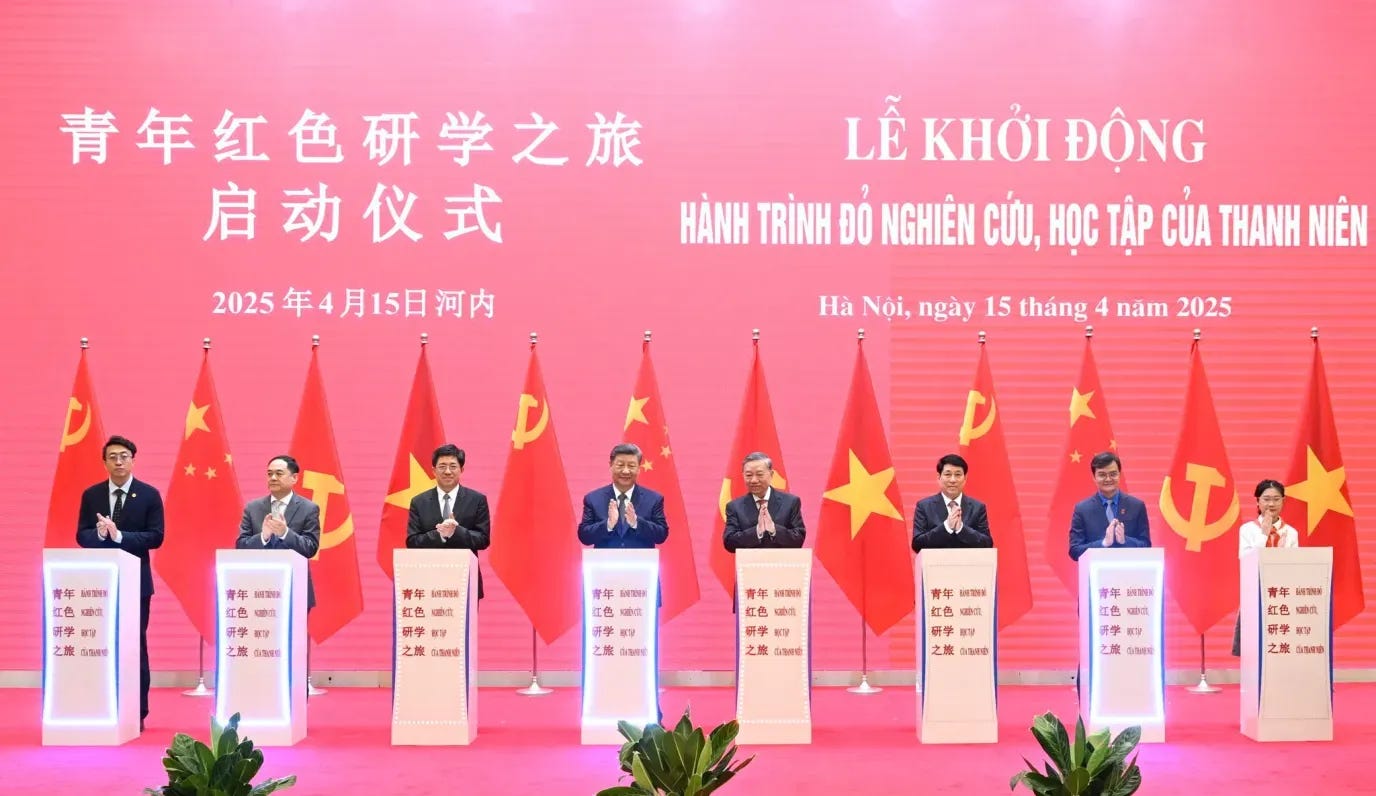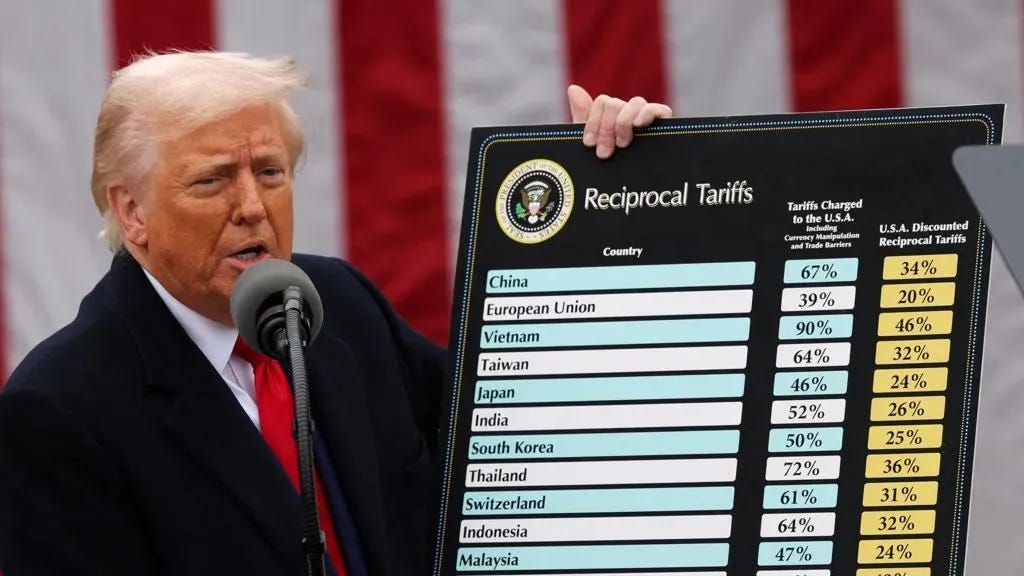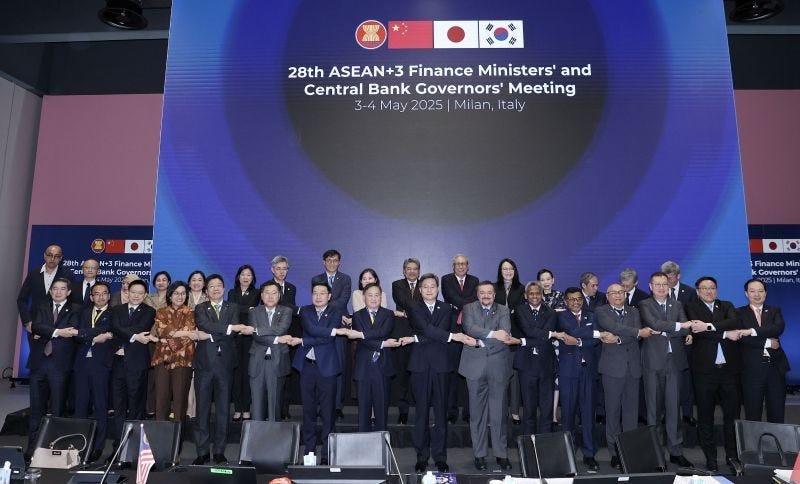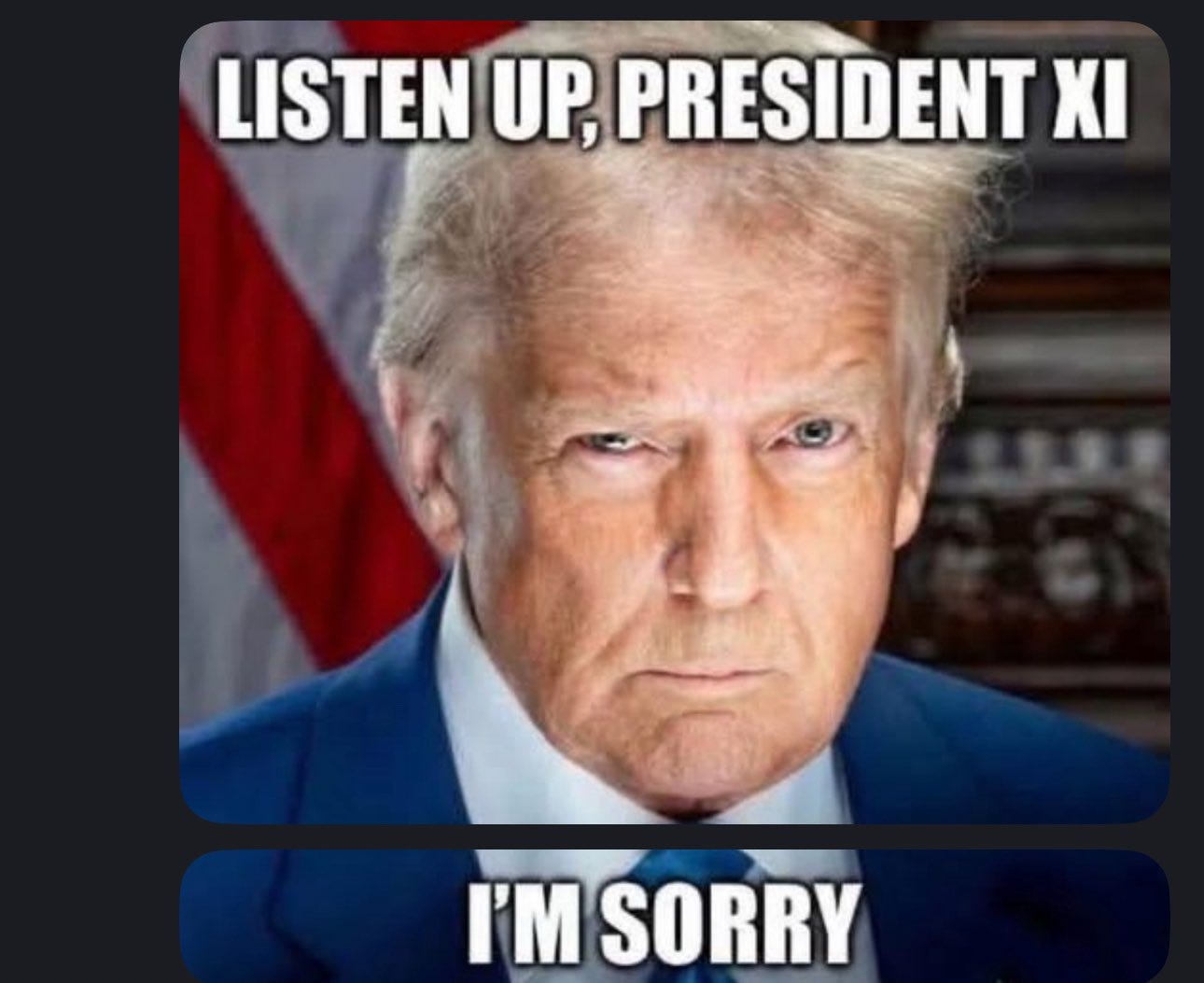Liberation Day, A Requiem? - War on China Emergency Report
All Is Indeed Well, at least for 90 days
For War on China’s initial Liberation Day assessment:
For assessments of the post Liberation Day course of events, read any of our many weekly updates since then, all of which covered the week’s developments in this field.
The United States nearly fully surrendered to Chinese demands at the Geneva trade talks. President Xi and the unswerving leadership of the CPC has been fully vindicated in its aggressive and hard headed response to the US tariffs. With the US staring down the barrel of massive economic disaster, Trump and his cronies have beat a hasty retreat from their disastrous economic war of choice.
The Road to Liberation Day
Trump ran and won in the 2024 US presidential election while campaigning on a massive increase in tariffs and a restructuring of the global trade system. Over the course of the first few months of the new administration, Trump began trade wars with Canada, Mexico, and China, though he was forced to delay much of the measures against Canada and Mexico amid a storm of business protests. The China measures remained in place though, and China chose to target its retaliatory measures carefully and surgically for the time being to avoid the worst potential impacts. However, a much larger tariff threat was waiting in the wings, with Trump and his officials planning a massive new tariff system in a bid to restructure the US economy. Trump officials floated a variety of reasonings behind their tariff planning ranging from rebalancing US trade in general, reindustrializing the US, achieving better free trade deals, achieving massive state revenues through the import taxes, driving down interest rates on US debt through an induced recession, decoupling from and harming China, etc. The Trump team set 2 April as their “Liberation Day” where Trump would announce his new tariff system.
Well, on 2 April 2025 Trump shot the entire global economy in the foot with massive “reciprocal” levies on most US trade partners and a 10% levy on all foreign imports into the US. These numbers were assembled purely based on how much the US trade deficit was with each country, and not relating to any actual substance in terms of trade or economic policy choices by the targeted countries, which led to the fairly protectionist UK being stuck with only 10% while impoverished exporters like Lesotho got stuck with 60%. The tariffs also struck US allies and enemies fairly indiscriminately, with US satellites like Japan being hit with massive tariffs along with neutral countries like Indonesia or enemies like China. Countries around the world, including US satellites, were horrified by this Trump attack on the global economy and the US repudiation of the free trade global economic order it itself had built. The tariff announcement led to an immediate downturn in financial markets, with stock markets around the world crashing immediately and US bond rates shooting up despite economic turmoil normally causing a decrease in US bond rates as investors buy US treasuries to flee to safety.
Most countries chose to avoid immediate retaliatory action after the Liberation Day tariffs, preparing for some kind of negotiations. China however had had enough of US economic aggression and announced a retaliatory across the board tariff matching the US Liberation Day imposition. Following a series of tit-for-tat tariff hikes US tariffs on Chinese goods sat at 145%, while Chinese tariffs on US goods sat at 125%. China also began squeezing in other areas with targeted efforts against select US firms, total cessation of certain US imports, and most notably an export embargo on rare earth metals which are needed for nearly all modern technology production. As the financial markets melted down though, Trump was forced into a near total retreat on his Liberation Day tariffs within a week. The so-called “reciprocal” duties on all countries except China were suspended for 90 days while negotiations got under way, but the massive US-China tariffs remained in place though, amounting to an effective embargo between the two. Treasury Secretary Scott Bessent seized control of the agenda and shifted away from other policy targets towards a focus on screwing over China. The stage was now set for a massive economic struggle between the world’s two largest economies.1
War of the Titans

With ruinous tariffs now imposed on the US-China trade, both countries began feeling the effects rather quickly. Since the first Trump term and the trade war then, the Chinese leadership had begun a major program to reduce reliance on exports to the US. China worked to diversify its export markets considerably towards the Global South, to the point where US exports made up less than 10% of Chinese exports by 2024 and less than 2% of GDP overall. Chinese officials also began a campaign to increase domestic consumption, which kicked into high gear at the start of 2025. Chinese technical progress made Chinese manufacturing and goods even more globally competitive and improved China’s internal consumption and self-sufficiency. Once the trade war began, Chinese officials immediately sprang into action to support and aid the economy in these trying times, providing financial assistance to impacted firms, finding new export markets, and calming investors. The Chinese public also rallied to the flag, supporting their govt in their countermeasures against US economic aggression and expressing a willingness to stand up to bullies no matter the costs. China also continued its efforts to build partnerships across the world, a task made much easier by such wanton US aggression.
By contrast the US position had only worsened since Trump’s first term trade war. A poorly thought out economic war with Russia, Biden era industrial policy that had mixed results at best, skyrocketing budget and trade deficits, and continued reliance on foreign imports for nearly everything resulted in a US that was hardly in a good position to fight a massive trade war with the world’s largest economy. Once the trade war began, US officials were nowhere to be found in terms of providing support to impacted businesses except for a few of the largest megacorporations if that. US business leaders and the public at large vociferously objected to the ruinous tariffs at once, and concerns about shortages all along the supply chain immediately began to surface. Hopes for rallying global support against China also faded fast as nearly all other countries, even US satellites, expressed no desire to side with the US against China.
Over the course of the remainder of April and early March, the Chinese advantage and US inferiority increasingly showed itself. China expressed continued confidence at all levels and applied itself vigorously to efforts to continue economic growth and to achieve their pre Liberation Day economic targets. China also found success in its efforts to rally countries against the US trade war, with a EU diplomatic thaw, a united ASEAN-South Korea-Japan effort to respond and deepen integration, increased trade and relations with South America, and others. The month of April concluded with a triumphant Chinese export report, with exports growing at a massive 8% instead of the 2% originally expected. The US by contrast entered into a severe crisis. Week after week of increasingly dismal economic reports and projections rolled out from every source in the US, from media, to business leaders, to the US govt itself. Non-China countries generally contented themselves with fairly slow negotiations expecting that Trump would be forced to retreat again, and with many demanding the full removal of tariffs. With the specter of mass shortages and economic ruination staring the US in the face, the Trump administration quickly began flailing about for both measures that would reassure the US economy and exit the mess they had made for themselves. Trump officials announced exemptions for imports of various consumer electronics from China, auto related tariff exemptions, and trumpeted a fake “deal” with the UK that was actually a non-binding framework memo, which itself was fairly favorable to the UK. None of these even came close to resolving the underlying cause of the ongoing economic crisis, the effective mutual embargo between the US and China. Trump officials blew hot and cold at the prospects of a China deal for weeks, alternately threatening further aggression, demanding talks, and offering concessions, often over the course of a single day. Chinese officials by contrast maintained a constant and clear message: China was willing to talk, but the US most show proper respect and immediately lift all Liberation Day related tariffs.2
The Dragon Triumphant
By early May, US officials had managed to convey both publicly and in back channels that the current arrangement was unsustainable and that they were ready to deal. Around that time, Chinese official statements began signalling a greater openness to discussions, confident in the knowledge that China now had the whip hand in any discussions. Shortly thereafter, a round of high level US-China trade talks were announced for Geneva, Switzerland on the weekend of 10-11 May . The US delegation was led by Treasury Secretary Scott Bessent and US Trade Representative Jamieson Greer, while China’s was led by Vice Premier He Lifeng and chief trade negotiator Li Chenggang. China’s demands on the talks being respectfully conducted, in private, and without any attempts at a US media circus were strictly adhered to.

The talks resulted in China achieving its goals. For the next 90 days, the US would remove nearly all Liberation Day related tariffs, plunging the US rate from 145% to 30%, with the 30% being the pre Liberation Day 20% “fentanyl tariff” plus the 10% universal rate now imposed on all US importers. China reduced its tariffs from 125% to 10%, removing most of the across the board retaliatory tariffs from Liberation Day except for a 10% duty to match the US universal tariff, as well as toning down some other Liberation Day retaliatory measures. In so doing, the US basically completely caved to China’s demand ever since this whole mess started, which was the complete removal of the Liberation Day “reciprocal” tariffs before any serious long term agreement negotiations began. With its victory on the core issue secured, China agreed to establish a formal mechanism going forward for continued US-China trade talks to resolve differences and further deepen commerce and cooperation between the two countries. China agreed to no other substantive concessions, promising neither investment agreements nor purchases of US goods, nor any other concessions ahead of the future talks.

US officials were forced to admit that their China decoupling idea had proven a catastrophic failure, and that the two countries were still economically bound to one another in a way that was not easily severed. Trump and his officials were forced into a far more conciliatory tone towards China, a marked contrast to the baboon-like chest beating over the previous month. Bessent’s comments expressed optimism about continued talks going forward, while Trump personally now claimed to not to want to hurt China and is offering to call President Xi later this week amidst a “total reset” for his administrations China relationship. Chinese officials meanwhile are all smiles amidst their vindication, touting deepening trade and cooperation as the best way forward and standing against protectionism and lose-lose trade wars. Chinese officials have reiterated their desire for greater cooperation and economic exchange, and complimented US officials on their professionalism and progress towards a deal.
Going forward, over the next 90 days the two parties will continue to hold economic talks and consultations to work towards a larger and lasting economic deal between the two superpowers. Bessent has publicly stated that Trump’s initial 34% “reciprocal” tariff towards China will now be the ceiling in negotiations going forward. The 10% tariff by the US and its matching equivalent by China is rather unlikely to be removed, as Trump officials have repeatedly outlined, even amidst their other reversals, that a 10% universal tariff towards all US imports will be the new normal. However the 20% “fentanyl tariff” is very much up for grabs, as US officials have expressed optimism towards engagement with China on the subject. China has expressed a willingness to cooperate on further joint efforts at drug control even though China has made clear that the US drug problem is ultimately its own fault and responsibility. In exchange for these joint drug control efforts, the US has floated removing at least some of the 20% tariff related to the issue. US officials have also voiced a desire to see increased Chinese purchases of US exports, increased Chinese investment opportunities for US firms, and some other economic arrangements. Chinese officials have advocated for greater commerce and cooperation generally, though their specific asks of the negotiations have been more secretive.

This Liberation Day mess has resulted, at least for the moment, in a near total Chinese triumph. The US trade war has been called off and the Trump administration is in full retreat amidst economic and political turmoil at home and abroad. None of the myriad goals Trump and his team floated for starting this whole thing in the first place have been accomplished. Virtually all countries have been alienated from the US and nobody has offered serious concessions, the real US economy has sputtered thanks to supply chain shocks, financial markets remain unstable amidst bond rates spikes, and reindustrialization plans collapse due to a shortage of Chinese made materials and economic uncertainty. China has suffered economic damage too, but has suffered less and responded to it far better. China will continue its successful work on economic development and win-win cooperation, while also further developing mechanisms to allow it to defend itself and retaliate against aggression. Leaders around the world are deepening their relationships with China and turning away from an increasingly unstable and weakening US, including US satellites and countries in the US’s backyard, as China defends the UN based international order and globalized economy and trade which all have come to rely upon. China’s defeat of the US trade war threat will also encourage other countries to take a harder line towards the US, who has now been shown to be a paper tiger. China’s standing up to US bullying has gained it greater public support across the globe as well, even in surveys by Western institutions. The future of the global system and humanity is still up for grabs, but it got a little more optimistic this week thanks to China’s stand for principle and sovereignty.3
Detailed sources for this section can be found in War on China’s intial Liberation day report linked at the top.
Detailed sources for this section can be found in the post Liberation Day weekly news updates from War on China
“US-China Trade Deal: Xi Defiance Pays off as Trump Meet Most Demands.” Bloomberg, May 12, 2025. https://www.bloomberg.com/news/articles/2025-05-12/xi-defiance-pays-off-as-trump-meets-most-chinese-trade-demands.
“Global Stocks Rise after US and China Agree to Slash Tariffs by 115% - Live Updates.” BBC News, May 12, 2025. https://www.bbc.com/news/live/cedy09wq25qt.
Yu, Wang, and Zhong Nan. “China, US Agree to de-Escalate Trade Tensions.” Chinadaily.com.cn, May 12, 2025. https://www.chinadaily.com.cn/a/202505/13/WS68228169a310a04af22bedde.html.
Cgtn. “China Releases White Paper on National Security in the New Era.” CGTN, May 12, 2025. https://news.cgtn.com/news/2025-05-12/China-releases-white-paper-on-national-security-1Djv8Sx3N3a/p.html.
“Global Perceptions of US Fall below China, Survey Says .” Reuters, May 12, 2025. https://www.reuters.com/world/global-perceptions-us-fall-below-china-survey-says-2025-05-12/.













